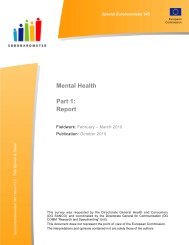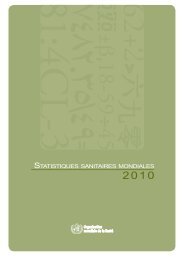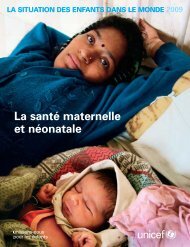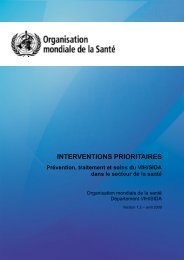Global Tuberculosis Control 2010 - Florida Department of Health
Global Tuberculosis Control 2010 - Florida Department of Health
Global Tuberculosis Control 2010 - Florida Department of Health
Create successful ePaper yourself
Turn your PDF publications into a flip-book with our unique Google optimized e-Paper software.
Estimated values are shown as best estimates followed<br />
by lower and upper bounds. The lower and upper<br />
bounds are defined as the 2.5th and 97.5th centiles <strong>of</strong><br />
outcome distributions produced in simulations.<br />
See for further details.<br />
Estimated numbers are shown rounded to two<br />
significant figures. Estimated rates are shown rounded<br />
to three significant figures unless the value is under<br />
100, in which case rates are shown rounded to two<br />
significant figures.<br />
Estimates for all years are recalculated as new<br />
information becomes available and techniques are<br />
refined, so they may differ from those published in<br />
previous reports in this series. Estimates published in<br />
previous global TB control reports should no longer be<br />
used.<br />
<br />
Graphs where displayed show data from all years within<br />
the range stated.<br />
<br />
Data shown in this annex are taken from the WHO<br />
global TB database on 31 August <strong>2010</strong>. Data shown<br />
in the main part <strong>of</strong> the report were taken from the<br />
database on 17 June <strong>2010</strong>. As a result, data in this<br />
annex may differ slightly from those in the main part <strong>of</strong><br />
the report.<br />
Data can be downloaded from www.who.int/tb/data.<br />
<br />
<br />
: the population estimate used by the NTP<br />
(148 million) is lower than that <strong>of</strong> the United Nations<br />
Population Division (162 million). Using the smaller<br />
population estimate gives a notification rate <strong>of</strong> 109<br />
per 100 000 population (all forms <strong>of</strong> TB) and 74 per<br />
100 000 population (smear-positive TB).<br />
Bangladesh completed a survey <strong>of</strong> the prevalence <strong>of</strong> TB<br />
disease in 2009. A reassessment <strong>of</strong> the epidemiological<br />
burden <strong>of</strong> TB, using data from the survey combined<br />
with an in-depth analysis <strong>of</strong> surveillance and<br />
programmatic data, will be undertaken in 2011.<br />
<br />
: the population estimate used by the NTP<br />
(1164 million) is lower than that <strong>of</strong> the United Nations<br />
Population Division (1198 million). Using the smaller<br />
population estimate gives a notification rate <strong>of</strong> new<br />
smear-positive cases <strong>of</strong> 116 per 100 000 population. The<br />
incidence <strong>of</strong> smear-positive TB has been estimated at 75<br />
per 100 000 population using data from surveys <strong>of</strong> the<br />
annual risk <strong>of</strong> infection. Using the notification rate for<br />
smear-positive TB <strong>of</strong> 54 per 100 000 population (using<br />
national estimates <strong>of</strong> population size) and a smearpositive<br />
incidence rate <strong>of</strong> 75 per 100 000 population<br />
gives an estimated case detection rate <strong>of</strong> 72%.<br />
<br />
Myanmar completed a survey <strong>of</strong> the prevalence <strong>of</strong> TB<br />
disease in <strong>2010</strong>. A reassessment <strong>of</strong> the epidemiological<br />
burden <strong>of</strong> TB will be undertaken following finalization<br />
and dissemination <strong>of</strong> survey results.

















